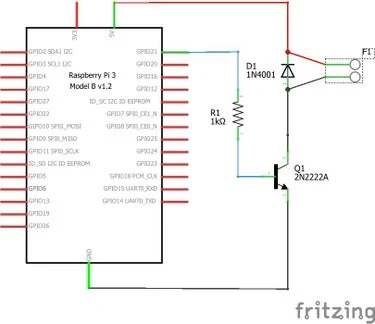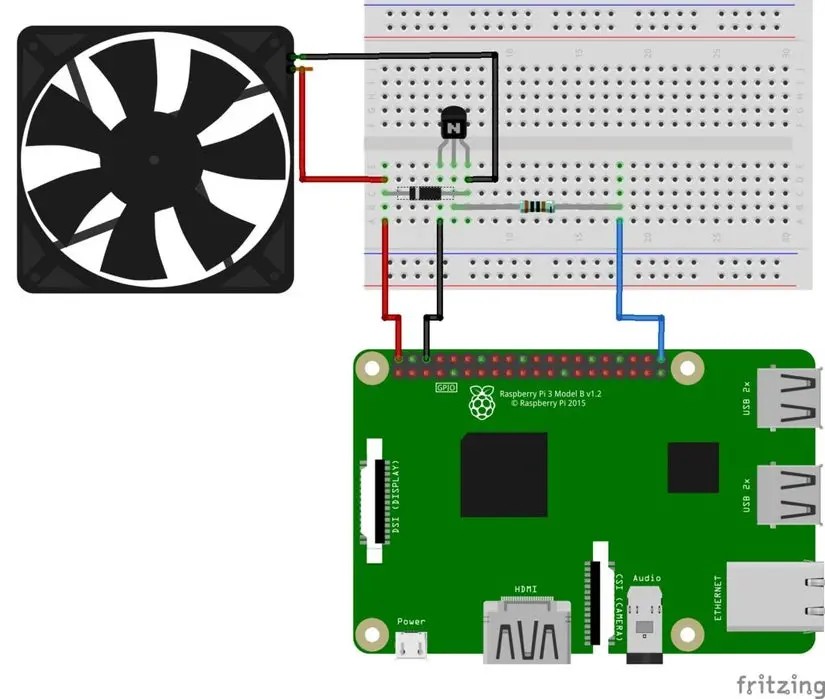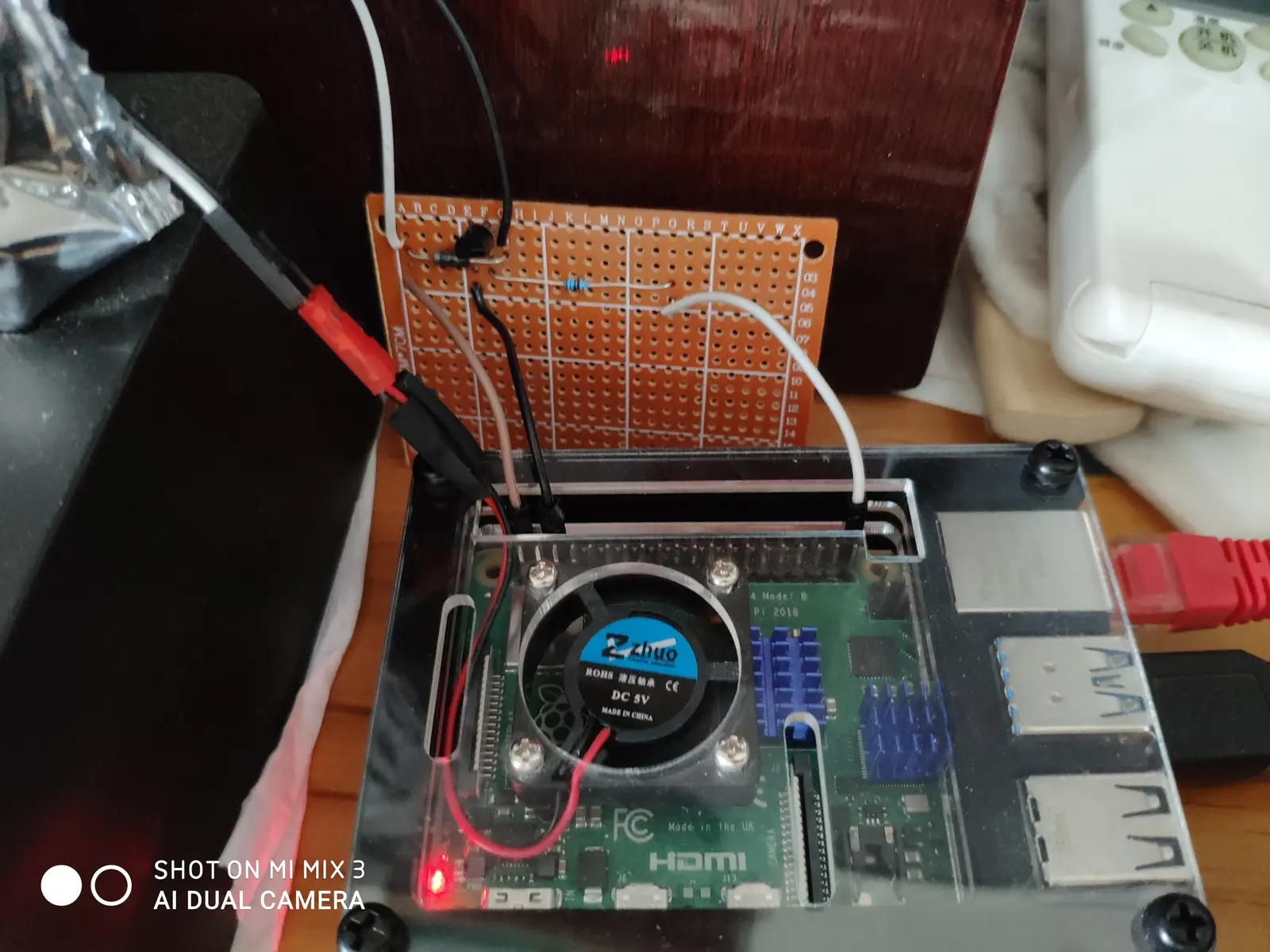# An Attempt Without Full Understanding
Circuit design: Zero basics.
Python: Zero basics.
Simply copied from: Aerandir14@Instructable Circuts.
 This article follows the CC-BY-NC-SA 4.0 license.
This article follows the CC-BY-NC-SA 4.0 license.
# Components
- Raspberry Pi 4B×1
- 5V Fan×1
- Prototype Board×1
- NPN Transistor 2N2222A×1
- 1KΩ Resistor×1
- Male-to-Female Jumper Wires×3
# Circuit Design
Circuit design as shown in the figure, all copied.


# Final Product
During practical operation, I directly cut one male-to-female jumper wire into two parts, using the female end to connect to GPIO and the male end to connect to the fan’s female end in mid-air.

# Usage
Using calib.py made by Aerandir14@Instructable Circuts to adjust the fan speed and understand the noise level at different speeds.
After python calib.py, the system will prompt to input the fan speed, then press Enter to confirm.
#!/usr/bin/python
# -*- coding: utf-8 -*-
import RPi.GPIO as GPIO
import time
import sys
#import os
FAN_PIN = 21
WAIT_TIME = 1
PWM_FREQ = 25
GPIO.setmode(GPIO.BCM)
GPIO.setup(FAN_PIN, GPIO.OUT, initial=GPIO.LOW)
fan=GPIO.PWM(FAN_PIN,PWM_FREQ)
fan.start(0);
i = 0
hyst = 1
tempSteps = [50, 70]
speedSteps = [0, 100]
cpuTempOld=0
try:
while 1:
fanSpeed=float(input("Fan Speed: "))
fan.ChangeDutyCycle(fanSpeed)
except(KeyboardInterrupt):
print("Fan ctrl interrupted by keyboard")
GPIO.cleanup()
sys.exit()
Then, use ctrl.py made by Aerandir14@Instructable Circuts to control the fan speed. Adjust tempSteps and speedSteps to personal preference, then run python ctrl.py.
Each temperature in tempSteps corresponds to a speed in speedSteps. If the temperature falls between two settings, the required speed will be automatically calculated linearly.
#!/usr/bin/python
# -*- coding: utf-8 -*-
import RPi.GPIO as GPIO
import time
import sys
# Configuration
FAN_PIN = 21 # BCM pin used to drive transistor's base
WAIT_TIME = 1 # [s] Time to wait between each refresh
FAN_MIN = 20 # [%] Fan minimum speed.
PWM_FREQ = 25 # [Hz] Change this value if fan has strange behavior
# Configurable temperature and fan speed steps
tempSteps = [45, 70] # [°C]
speedSteps = [0, 100] # [%]
# Fan speed will change only of the difference of temperature is higher than hysteresis
hyst = 1
# Setup GPIO pin
GPIO.setmode(GPIO.BCM)
GPIO.setup(FAN_PIN, GPIO.OUT, initial=GPIO.LOW)
fan = GPIO.PWM(FAN_PIN, PWM_FREQ)
fan.start(0)
i = 0
cpuTemp = 0
fanSpeed = 0
cpuTempOld = 0
fanSpeedOld = 0
# We must set a speed value for each temperature step
if len(speedSteps) != len(tempSteps):
print("Numbers of temp steps and speed steps are different")
exit(0)
try:
while 1:
# Read CPU temperature
cpuTempFile = open("/sys/class/thermal/thermal_zone0/temp", "r")
cpuTemp = float(cpuTempFile.read()) / 1000
cpuTempFile.close()
# Calculate desired fan speed
if abs(cpuTemp - cpuTempOld) > hyst:
# Below first value, fan will run at min speed.
if cpuTemp < tempSteps[0]:
fanSpeed = speedSteps[0]
# Above last value, fan will run at max speed
elif cpuTemp >= tempSteps[len(tempSteps) - 1]:
fanSpeed = speedSteps[len(tempSteps) - 1]
# If temperature is between 2 steps, fan speed is calculated by linear interpolation
else:
for i in range(0, len(tempSteps) - 1):
if (cpuTemp >= tempSteps[i]) and (cpuTemp < tempSteps[i + 1]):
fanSpeed = round((speedSteps[i + 1] - speedSteps[i])
/ (tempSteps[i + 1] - tempSteps[i])
* (cpuTemp - tempSteps[i])
+ speedSteps[i], 1)
if fanSpeed != fanSpeedOld:
if (fanSpeed != fanSpeedOld
and (fanSpeed >= FAN_MIN or fanSpeed == 0)):
fan.ChangeDutyCycle(fanSpeed)
fanSpeedOld = fanSpeed
cpuTempOld = cpuTemp
# Wait until next refresh
time.sleep(WAIT_TIME)
# If a keyboard interrupt occurs (ctrl + c), the GPIO is set to 0 and the program exits.
except KeyboardInterrupt:
print("Fan ctrl interrupted by keyboard")
GPIO.cleanup()
sys.exit()
# Automatic Running
After testing, configure systemd for background running. Modify /etc/systemd/system/fanctrl.service.
[Unit]
Description=PWM Fan Control
After=mediacenter.service
[Service]
Type=simple
User=root
ExecStart= /usr/bin/python <path to ctrl.py>
Restart=always
[Install]
WantedBy=default.target
Then use systemctl to start the service.
sudo systemctl daemon-reload
sudo systemctl enable fanctrl
sudo systemctl start fanctrl
# All Done
If you, like me, can’t stand temperatures above 50 degrees; if you, like me, think the fan provided by the store is too noisy, then try making one yourself! Let the fan no longer disturb the security guard downstairs. May the world be free from noise.